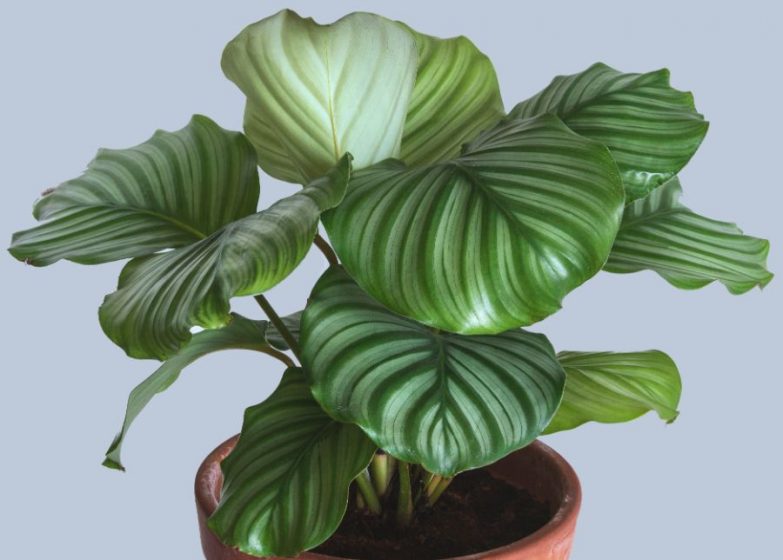The Calathea orbifolia’s oversized leaves are striped with silvery bands that are tastefully beautiful in a simple way. It’s one of those plants that triggers a must-have purchase – but Calathea orbifolia care can be a challenge if you want to keep your plant looking radiant. This article will explain what needs to be done to care for Calathea orbifolia and keep it looking like the tropical beauty you fell in love with.
Calathea orbifolia care summary: Calathea orbifolia loves well-draining soil that never gets dry or soggy, medium light and high humidity. It thrives at temperatures of 65°F (18°C) to 75ºF (24ºC) and is happy with a balanced fertilizer applied monthly at 1/4 to 1/2 strength during the growing season.
Calathea Orbifolia Overview
A South American prayer plant kept for its clean, designer-quality foliage, Orbifolia is one of the largest Calatheas. Its bold oval leaves can grow over a foot across – it makes a classic statement plant.
Calatheas can be fussy and the Orbifolia is no exception. Its attractive foliage and well-balanced profile attracts smitten owners, some of whom sadly watch the lovely plant slowly disfigure itself and decline. Why? Because love is not enough.
Orbifolias require high humidity and consistent soil moisture to thrive. Owners who brag about how easy it is to keep Orbifolias often fail to mention they live in a tropical area. If your home is dry, you’re at a disadvantage.
There’s no need to fear a Calathea orbifolia, however, only to understand it. Give it jungle-like conditions that include warmth and moisture, and you’ll both be happy.
It’s safe for pets and children: they will likely be more in danger from you if they eat it. Calathea orbifolia can be hard to find, though it’s becoming easier as their popularity grows.
Calathea Orbifolia Care Requirements
- Scientific Name: Calathea orbifolia ( Now officially Goeppertia orbifolia)
- Origin: Bolivia
- Light Requirements: Medium, filtered light
- Watering: Maintain moist soil with regular watering, but do not let the soil become soggy. Use filtered, distilled or rainwater ideally.
- Soil: Well draining potting mix. A good mix is two parts peat/coir and one part perlite. Here are some ideal pre-made Calathea mixes.
- Temperature: 65°F (18°C) to 75ºF (24ºC)
- Fertilizer: Monthly while actively growing with 1/4 strength, balanced fertilizer. Flush the soil several times per year.
- Humidity: Needs high humidity to keep foliage looking well.
- Pruning: Minimal pruning requirements. Prune old or yellowed leaves.
- Propagation: Propagate by division in late spring/early summer. Can be tricky.
- Re-Potting: Calathea orbifolia doesn’t like to be repotted too often. Only once root-bound.
- Diseases and Pests: Damp conditions can promote fungus, powdery mildew & leaf-spot, but their most deadly vulnerability is root rot. Thrips and other leaf suckers can present at times.
- Toxicity: Non-toxic to humans and animals.
- Where To Buy: Buy Calathea orbifolia online at Etsy (I buy most of my houseplants from Etsy).
Calathea Orbifolia Care Video
Check out my video about Calathea orbifolia (Goeppertia orbifolia). It covers everything in this article and provides more helpful tips to keep your plant thriving.
Orbifolia Characteristics
Orbifolia is a perennial that lives on forest floors in its native Bolivia. It’s a member of the Marantaceae or Prayer Plant family that prefers semi-shade; it can tolerate low light but not direct sun.
The rounded oval leaves have crisp silvery gray and green bands and thick individual stems. Their undersides are pale green. The plant can reach about three feet high and wide when grown indoors.
If you look at the plant and it seems different, it’s probably not your imagination. As a prayer plant, the Orbifolia’s leaves are highly animated and move throughout the day.
While they make excellent houseplants, Orbifolias can be grown outdoors in USDA Zones 9b-11. It can also summer outside and be brought indoors in the fall, but it cannot tolerate even short periods of cold without damage. Its growing speed varies with conditions, but it’s never a very fast grower and goes semi-dormant over the cool season.
The Orbifolia has a rhizome root structure and is prone to rot. It needs a rich mix that drains well, but it doesn’t tolerate overly dry soil either.
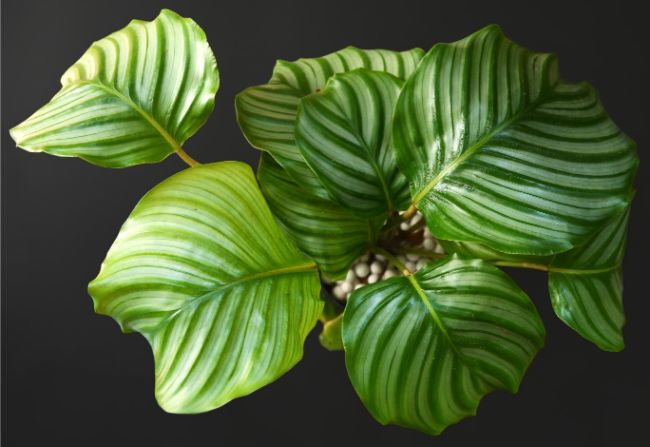
Calathea Orbifolia Light Requirements
Orbifolias grow naturally in bright forest shade and need to be kept out of direct sun. Overly bright light will fade and even damage their leaves.
They do best in medium or even lower light, though you should avoid dim conditions. One way to tell if the light is sufficient is if you can easily read in it.
A north-facing window is often ideal, but they can take some gentle morning sun from an eastern exposure.
How To Water Calathea Orbifolia
Watering is a key topic in keeping your Orbifolia healthy and looking its best. Its tropical nature means it likes the soil to be evenly moist and never completely dry.
To achieve the right moisture level, check the soil and rewater when the top inch or two are almost dry. This helps prevent moisture-related pests and disease, but don’t let it get too dry. The leaves won’t wilt to tell you they’re thirsty; they just decline. You can check by hand, or use a moisture meter for greater accuracy.
Knowing when and how to water indoor plants, particularly calatheas is a hugely important and underrated skill. I’ve written several articles to help you master the art of providing perfect amounts of water for your plants.
Note: If your plant’s leaves become less dynamic or don’t fold up at night, it may be a sign they need more water.
A terra cotta pot can make the soil dry out too fast. One good option is to use a plastic pot that holds moisture in, and place it inside a decorative pot without drainage holes. Add a layer of pebbles at the bottom of the outer pot to elevate the inner planter: this provides drainage space while putting some moisture into the air surrounding the leaves.
You can simply moisten the soil when watering, but occasionally water more thoroughly and let the pot drain for 10 minutes or so. This helps flush the soil and ensure the peat stays evenly moist.
Some owners have success with self-watering devices that slowly release water into the soil. If working properly, they are regulated by the soil moisture and release water gradually to keep the mix evenly damp.
Calathea orbifolia is sensitive to water salts, chlorine, and build-up from old fertilizer, so it’s recommended to use filtered or purified water. If you’re seeing leaf discoloration, water quality could be the culprit.
Calathea Orbifolia Needs Jungle Soil
Your Calathea orbifolia’s soil is an important element in keeping right the moisture level. It should drain quickly but retain some water. It should also include organic fertility for best results.
Peat or coco coir will hold in moisture while allowing the roots to breath, but add enough drainage material to avoid sogginess. Perlite and pumice are good for drainage, but vermiculite holds a bit too much water.
A good mix is two parts peat/coir and one part perlite or pumice. Orchid bark can also work for organic drainage, but it does break down over time.
Including organic amendments to build a rich soil is safer than using synthetic fertilizers. Orbifolia’s roots react poorly to inorganic residues. Consider adding compost: not only is it a nutritious medium that plants naturally grow in, but it helps condition the soil to have ideal moisture and drainage.
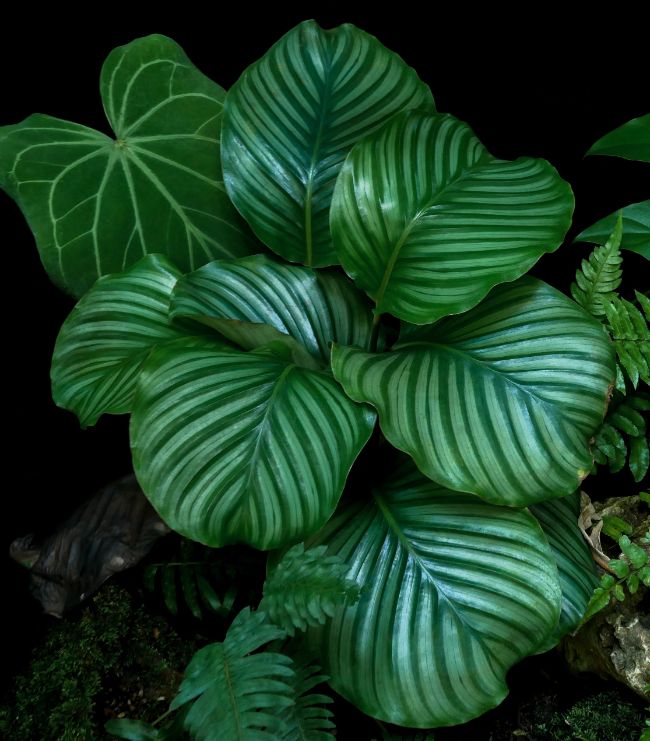
Calathea Orbifolia Temperature Needs
Our normal indoor temperatures are perfect for this tender tropical—they like from 65°F (18°C) to 75ºF (24ºC). They can take a couple of degrees more, but if their leaves start to curl the temperature is too high. 60ºF (15ºC) is pushing their lower limits.
Leaves are apt to show damage if the plant gets even a minor chill. They protest drafts and short drops below its preferred range. They don’t appreciate sudden changes, either.
If you summer your indoor Orbifolias outside, take them in before temperatures dip into the mid-50s.
Fertilizing Calathea Orbifolia
Orbifolia isn’t a heavy feeder, but they do appreciate light, regular fertilization during their growing season. Organic feeding is a good option because it avoids damaging their sensitive roots.
I use a balanced, water soluble formula, made up at 1/4 of the recommended strength. I use this once per month from spring to fall, and hold off during the winter. If you’re using a dry fertilizer, apply it a few inches away from the plant’s base for a safety margin.
High Humidity
Another key factor to keeping happy Orbifolias is high humidity of 50% or more. The plant may survive in drier air, but it won’t look its best – and then, what’s the point?
An inexpensive hygrometer is a good investment to ensure the right conditions. Here are ways to raise the humidity:
Grouping – This tried-and-true method is nature’s way. Don’t overcrowd the plants—you don’t want them to share bugs or interfere with air circulation—but keep them close enough to let mutual transpiration do its thing.
Humid Location – Bathrooms offer a steam treatment with every shower and make great high-humidity sites if the light is right. Kitchens and laundry rooms are other spots to consider.
Pro Tip: Hang your washing to dry in the room with your Orbifolia; it’s good for five or ten percent more humidity for a couple of hours.
Pebble-filled Trays – Setting little reservoirs of water around your plants raises ambient moisture through evaporation. It’s not an enormous effect, but it is steady and certain. You can also use pebbles to set their pots above the water line in a saucer or tray.
Sea-Shells – Expand on the evaporation concept by placing some shells hollow-side up on top of the soil. Fill them when water to give the leaves close-range moisture.
Misting – Establish a misting schedule to supplement humidity. Use a sprayer with fine droplets and purified or filtered water. Morning misting is best to give the plant a nice boost for the day.
Humidifier – The maxim that beauty takes effort is exemplified in getting a room humidifier for your plant. It’s an expense and a maintenance chore, but with the right unit you can have flourishing Orbifolias even if you live in a desert.
Forget Flowers
Calathea orbifolia is grown for its layers of gorgeous leaves, not its flowers. There are rumors the plant produces a white stem-like blossom in the wild, but you can safely forget about them.
No Pruning Necessary
Since this plant is basically a set of single-leaved stems, there are no branches to prune. The only maintenance they need is removal of brown, yellowing or damaged leaves. This won’t affect future growth.
Cut near the base near the main stem. Remember to sterilize your tools before and after: a quick wipe with rubbing alcohol is fine.
Propagating Calathea Orbifolia
In spite of the popularity and collector’s appeal of the Orbifolia, it’s still uncommon – the difficulty of propagating them is a big reason why. Propagation through seeds or cuttings isn’t always successful; rhizome division is the accepted method.
The caution here is that Orbifolias don’t like being disturbed. You could be risking the plant, so proceed carefully!
The best time to attempt propagation is in the early part of their growing season to give the divisions time to recover. Avoid traumatizing the roots.
- Unpot the mother plant and gently tease the rhizome from the soil.
- Cut a section from the tuber with a sterilized blade, making sure it includes at least one stem and some roots.
- Repot in suitable soil.
- Keep the plants warm and moist as they recover. Cover the new plant(s) with a transparent plastic enclosure and mist daily.
- When you see new growth, remove the plastic covering. Water carefully as the plants establish themselves.
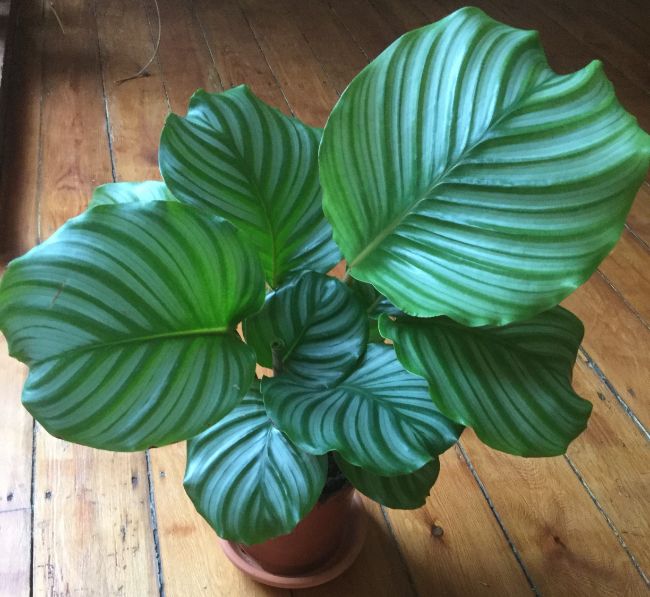
Calathea Orbifolia Planting Tips
An Orbifolia can react poorly to conditions other plants take in stride. Here are tips to staying out of trouble:
Water Quality
Orbifolia’s tropical roots are sensitive to chemicals, and any negative reaction they have to contaminants is reflected in their leaves. It’s recommended to use rainwater or purified water; at the very least it should be dechlorinated. The same goes for water used for misting.
Let A New Plant Rest
Traveling shakes this plant up, so don’t disturb it more than necessary. Place it in a suitable spot, water as needed, and let it relax: don’t prune or repot or take pictures of it on your bed. Bring it gradually up to a regular feeding schedule.
Keep The Same Pot
Even a well-acclimated Orbifolia likes its roots and soil to remain stable. Put it inside a more decorative container if you’d like; but, unless there’s a real issue with its original soil, give it a season before repotting.
Re-Potting Calathea Orbifolia
Repotting can really stress out an Orbifolia, so take it easy. Some specimens live for years in the same soil, but you don’t have to go to extremes: giving it fresh soil or repotting to a larger container (if needed) can be done every year or two.
If you are seeing slower growth, it may be time to repot. It doesn’t like being rootbound.
A pot with an 8- or 10-inch diameter is usually sufficient for an indoor plant. Try not to unduly disturb the roots. Pat down the soil but don’t press too firmly—you want the mix to retain some fluffiness.
Varieties
There are over three hundred Calathea cultivars, but only one Orbifolia. It may be called a Goeppertia or Maranta orbifolia, but it’s the same plant.
Diseases And Pests
The damp conditions an Orbifolia needs can promote moisture-loving ailments like fungus, powdery mildew & leaf-spot, but their most important and most deadly vulnerability is root rot. Letting the topsoil dry slightly before watering is a helpful prevention. Keep an eye out to catch problems early.
The oversized, luscious leaves naturally attract insects like aphids, mealybugs, whitefly, and thrips. Check regularly for discolored areas or webs. At the first indication of unwelcome visitors, use neem oil or a horticultural spray as directed.
Thrips in particular can quickly suck life out of your showpiece. An infestation produces brown and yellow patches on the leaves, and you may also see bruised-looking areas underneath. Their eggs are too small to see but can be laid in the soil, so change the top two inches of the mix when you treat them.
If sprays aren’t enough, predatory mites may be another natural solution. Determine what is eating your plants and pick the variety of mites that consider them prey. The mites are dusted over the plant and soil and are harmless to pets and humans.
Constantly moist soil also invites soil gnats. Letting the topsoil dry between waterings is the easiest prevention. Some owners sprinkle a ¼ inch or so of sand over the surface; the sand dries quickly to discourage the pests. Another solution is to mix food grade diatomaceous earth into the topsoil—this silica product kills larva and interrupts their life cycle.
Toxicity
Calathea orbifolia is non-toxic to pets and people. That doesn’t meant they’ll make a good salad, but the only harm likely in eating them is an upset stomach.
Common Questions About Calathea Orbifolia Care
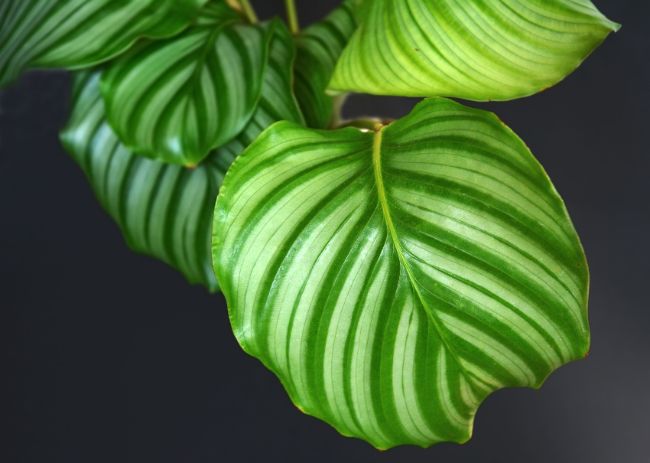
Why Does My Calathea Orbifolia Have Brown Edges On The Leaves?
Underwatering and low humidity are the most common causes of Calathea orbifolia leaves turning brown, either in patches or at the edges.
Sometimes underwatering leads to chronic issues. Peat is common in Orbifolia soils, but if it dries it can actually repel water and leave the mix dry in spots. One noninvasive way to check is to insert a wooden chopstick before watering. Pull out the chopstick from the watered mix and see if it’s evenly moist.
Low humidity can also cause brown leaves; watering or misting with unfiltered tap water is another possibility. Overfertilization can turn the tips brown.
Why Is My Calathea Orbifolia Drooping?
This can be a gray area. Underwatering is the primary suspect, but check for root rot beforehand: if rot is the cause, watering is the last thing to do. Insects can cause this, but the leaves will usually begin yellowing if they have an infestation.
Sometimes drooping leaves are simply starting to decline from age. They could just be responding to the light. If you can’t find a definite cause, keep the plant under observation for visible damage developing on the leaves.
Why Are My Calathea Orbifolia Leaves Curling?
The most common reason is lack of moisture, so check the soil and local humidity. Orbifolia will also curl its leaves if the temperature is cooler than they like. Read my article which covers all the common causes and solutions for curling calathea leaves.
Why Is My Calathea Orbifolia Drooping After Repotting?
Repotting can shock an Orbifolia, so expect some recovery time. Make sure the soil is consistently moist and that they have both high humidity and medium light without direct sun. Don’t dig it back up, prune, fertilize, or move it around to see instant results. Benign neglect can work wonders with this plant as long as they have good light and proper moisture.
How To Prevent Yellowing Leaves On Calathea Orbifolia
Yellow leaves is often caused by watering problems such as overwatering or underwatering. Leaves will also turn yellow when the plant is stressed by temperature extremes, drafts or a recent change in location.
Sometimes a beautiful new Calathea orbifolia will develop some leaf yellowing as it acclimatizes to your home. Focus on providing ideal conditions and the plant should recover.

